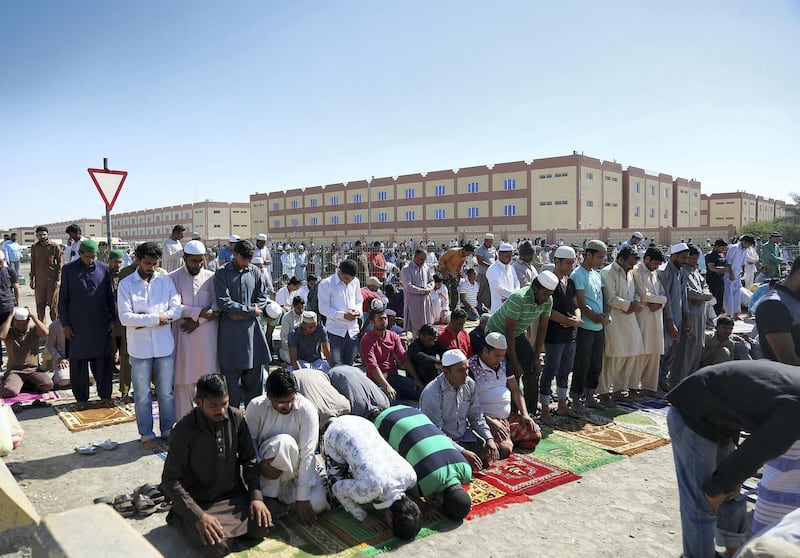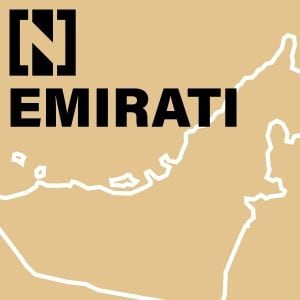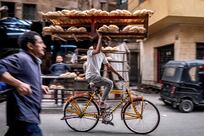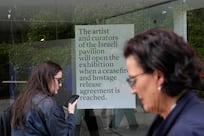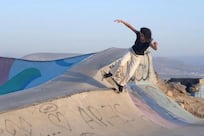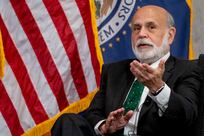“Too much heat, too much sunshine,” says Mohammed Imran, tapping his fingers on a counter.
Mr Imran is one of hundreds who spends Fridays praying on the streets of Mussaffah, the industrial district on the outskirts of Abu Dhabi.
In the cool winter months, as at present, the impact is negligible.
But in the summer, the pavements get so hot from temperatures approaching 50°C that he moves his feet back and forth like a skittish cat. Worst still, he says, is when he kneels and puts his sweating forehead to the ground in supplication.
"First the feet burn, then the head," said Mr Imran, 30. "So much burns. The ground is too hot. It gets so you cannot stand on the ground to pray."
As the industrial area of Mussaffah grows and its makeshift caravan-mosques disappear, workers are forced to pray on the streets.
Those interviewed said the situation has not improved since The National visited in June 2015, when we reported on thousands praying outside the Industrial City Abu Dhabi (Icad) labour accommodations.
The Icad complex is home to 26,000 workers and has one of the few mosques in the area, attracting not just its own residents but men like Mr Imran who work in the area. The situation has not improved since Mr Imran arrived five years ago to work at the nearby Qamar Punjab Restaurant.
It is not just at Icad. A five-minute drive away, the Abdullah bin Shaiban #269 mosque overflows on Fridays and during Ramadan. It has a total capacity of 1,200 worshippers but its imam estimates that 2,000 attend Friday prayers.
In wealthier neighbourhoods, families donate to local mosque construction but Mussaffah is home to low-income workers who earn hundreds of dirhams a month, not thousands.
“People are poor and they’re not able to pray here the nationals and the people with money are in other areas,” said its imam of 29 years, Moluana Fairouz Ahmed. “This is a working area for the poor.”
Imam Ahmed keeps sermons short in summer to accommodate workers.
“There are not many places to pray,” he said. “The whole area is full on Friday. Mussaffah was small and now it’s become big, as big as Abu Dhabi, mashallah. We need more mosques.”
For years, the solution was the humble porta-mosque, caravans and temporary concrete structures colourfully decorated with posters of Mecca and crescents cut from plywood. These simply structures were once plentiful in Mussaffah.
In 2008, the construction permits director at the Abu Dhabi Municipality, Khalfan Al Nuaimi, declared that mosques should be "nice buildings" and said "the idea of the temporary mosque is finished" .
A few months later, the Mosque Development Committee was established under Falah Al Ahbabi, general manager of the Urban Planning Council (UPC), to set guidelines for the development and management of all mosques in compliance with Plan Abu Dhabi 2030.
Mr Al Ahbabi said guidelines to be issued in 2010 would "define the urban character of the city" and "preserve Abu Dhabi's Emirati, Arab and Islamic identity".
_______________
Read more:
A simple prayer: the UAE’s porta-mosques
No walls, but plenty of support for this Abu Dhabi mosque
How Mussafah is undergoing a quiet transformation
_______________
At the same time the mosques have disappeared, Mussaffah’s population has quickly grown, representing a fifth of Abu Dhabi’s commercial licences.
Traditionally a labour area, it is growing popular with the middle class.
The Abu Dhabi Urban Planning Council and the General Authority of Islamic Affairs and Endowments did not respond when approached for comment about future plans to build more mosques in the area.
But under Future Vision of Mussaffah plan, approved by the Abu Dhabi Exeuctive Council in 2016, will see government investments in its roads and a 7.5-kilometre water front development.
“In Mussaffah, this is the main thing. There are not many mosques,” said Sabir Zaman, 24, a taxi driver who regularly worships at Abdullah bin Shaiban #269 mosque.
Driving around, he points to empty spaces and the absence of minarets. "Look, here is no mosque. No mosque here. You look in all areas, you look - no mosque."
Mr Zaman struggles to pray in his room, which he shares with 16 people. Praying in the space between triple-bunks can be tricky but it is easier than standing on the road in summer when temperatures routinely exceed 40°C. However, the taxi driver has little choice during Ramadan, when the mosques are so busy that there is no space in the mosque or anywhere around it.
“In Ramadan, especially, I pray in my room. The mosque is far. We are forced. Praying is a necessity.”
Mr Zaman’s suggestion is a simple one.
“Make more mosques. This is very necessary.”
